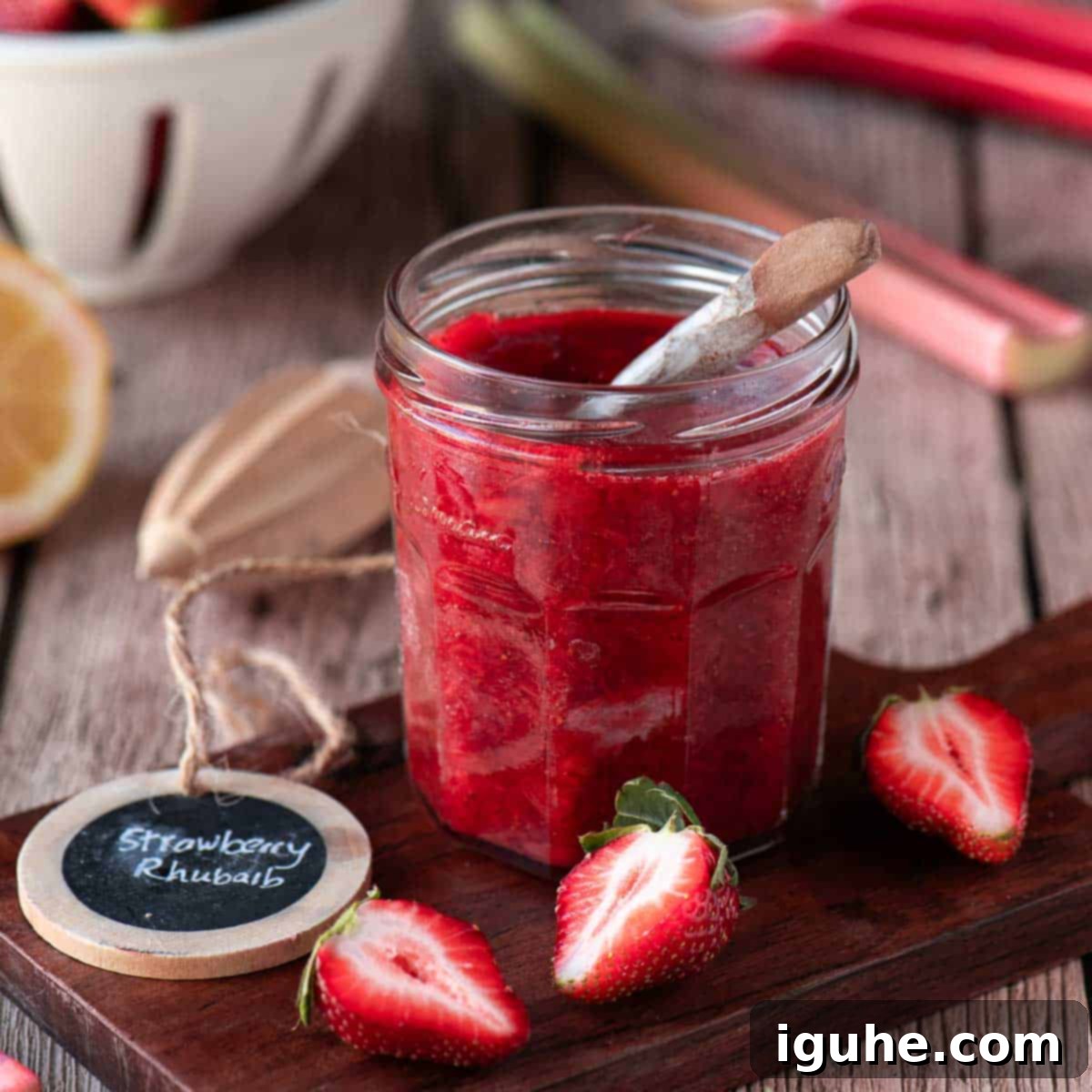Easy Small-Batch Strawberry Rhubarb Jam: Homemade Sweetness Without the Fuss
Imagine the vibrant taste of sun-ripened strawberries mingling with the delightful tartness of fresh rhubarb, all captured in a luscious, homemade jam. This Small-Batch Strawberry Rhubarb Jam recipe is your perfect ticket to preserving the essence of spring and summer in a jar. Forget the daunting task of large-scale canning or the need for commercial pectin; this recipe is designed for ease, yielding just enough exquisite jam to enjoy fresh, all week long, with minimal effort.

The culinary world often celebrates certain pairings as “matches made in heaven,” and strawberries and rhubarb undoubtedly belong on that list. This iconic duo is a beloved staple in spring and summer desserts, from pies to crumbles, and for all the right reasons. Strawberries contribute a luscious natural sweetness, while rhubarb introduces a bold, invigorating tang. This creates a delectable contrast that brightens the palate, all while boasting a stunning, double pink-to-red hue that is as appealing to the eyes as it is to the taste buds.
This particular jam recipe stands out for its simplicity, making it ideal for beginners venturing into the world of homemade preserves. There’s no need for complicated canning procedures, added pectin, or any specialized, fancy equipment. With just a handful of fresh ingredients and a single pot, you can create a beautiful batch of jam that’s perfect for your breakfast toast, stirred into yogurt, or even as a thoughtful, edible hostess gift. It’s a truly uncomplicated way to enjoy the freshest flavors of the season.
Why Choose Small-Batch Jam?
In a world often focused on quantity, small-batch cooking offers a refreshing alternative, especially when it comes to preserves. Opting for a small-batch jam recipe, like this strawberry rhubarb delight, comes with a multitude of benefits:
- Simplicity and Speed: Without the need for extensive canning equipment or processes, small batches are quicker to prepare from start to finish. You can whip up a fresh batch in under an hour!
- No Special Equipment: You don’t need a water bath canner, special jars, or even pectin. A simple pot and a spoon are all you require.
- Freshness Guaranteed: Small batches mean you’ll enjoy the jam at its peak freshness. It’s made to be savored over a few weeks, ensuring maximum flavor.
- Less Waste: No overflowing pantry shelves or forgotten jars. You make just enough to enjoy, reducing potential food waste.
- Perfect for Gifting: A charming small jar of homemade jam makes an incredibly thoughtful and personal gift for friends, family, or as a hostess thank-you.
- Experimentation Friendly: Small batches are perfect for trying out new flavor combinations or adjusting sweetness levels without committing to a huge amount of ingredients.
The Perfect Pairing: Strawberries and Rhubarb
The harmonious marriage of strawberries and rhubarb is a culinary tale as old as time, celebrated in kitchens worldwide, particularly during their peak seasons. But what makes this combination so irresistibly good?
A Symphony of Flavors
Strawberries, with their luscious sweetness and subtle floral notes, provide a soft, welcoming base. They’re the sunshine in the jar, bringing that unmistakable taste of summer. Rhubarb, on the other hand, is the feisty counterpart. Its characteristic tartness, sometimes described as a green apple or lemon-like zest, cuts through the strawberry’s sweetness, creating a perfectly balanced flavor profile that is neither too sweet nor too sour. This interplay of sweet and tart is what truly elevates the jam, making it complex and deeply satisfying.
The Visual Appeal
Beyond taste, the visual appeal of strawberry rhubarb jam is undeniable. The vibrant red of ripe strawberries blends beautifully with the rosy-pink hues of cooked rhubarb, resulting in a jam that’s not just delicious but also a feast for the eyes. Each spoonful promises a burst of color, making it an attractive addition to any breakfast table or dessert platter.
Gather Your Ingredients
Creating this delightful jam starts with selecting the best quality ingredients. Here’s a closer look at what you’ll need and how to pick them:
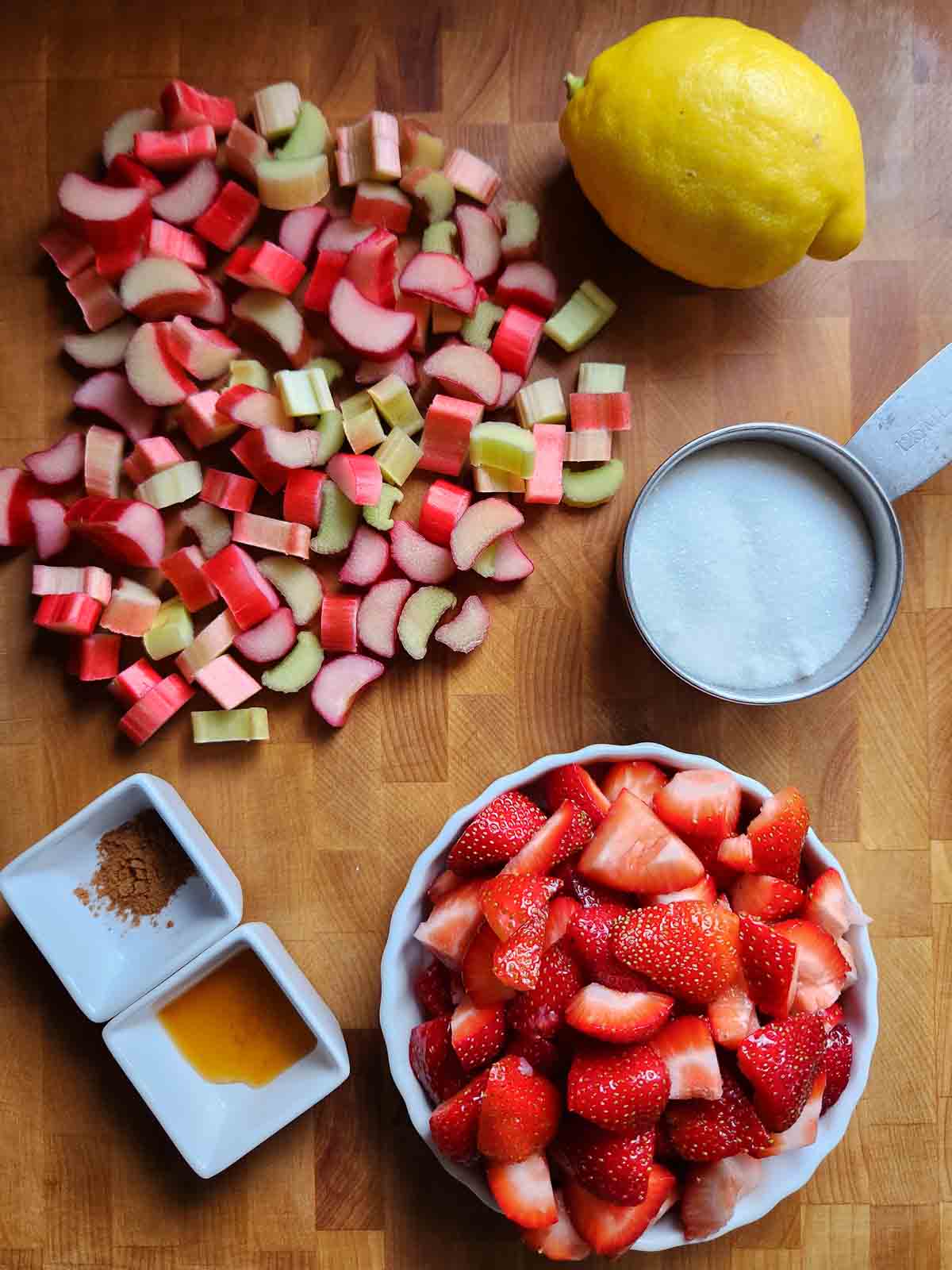
- Strawberries: For the most flavorful jam, always opt for fresh, ripe strawberries. Look for berries that are bright red, plump, and aromatic. While supermarket strawberries in plastic containers are convenient, those from a local farmer’s market often boast superior sweetness and flavor. Taste them before you start to gauge their natural sugar content; this will help you determine how much additional sugar your jam needs.
- Rhubarb: Seek out firm, crisp stalks with a vibrant red or pink hue. While some varieties are greener, the redder stalks generally impart more color to your jam. Avoid any limp or bruised stalks. Remember, rhubarb leaves are toxic and should never be consumed; they are typically removed before sale. For more details on selecting and preparing rhubarb, check out our FAQ section below.
- Lemon juice: A splash of fresh lemon juice is crucial. It not only brightens the fruit flavors but also provides natural pectin (even without added commercial pectin) and helps balance the sweetness. If you don’t have lemon on hand, fresh orange juice can be a pleasant, slightly sweeter substitute.
- Sugar: Granulated white sugar is used here to sweeten the jam and aid in its setting process. The amount can be adjusted based on the sweetness of your fruit and personal preference. Don’t be afraid to taste and tweak!
- Vanilla: I’m particularly fond of vanilla bean paste for its rich, complex flavor and those charming little specks of vanilla bean. However, pure vanilla extract works beautifully as well, adding a warm, aromatic depth to the jam.
- Cinnamon: A hint of ground cinnamon introduces a subtle warmth and comforting spice, complementing the fruit flavors without overpowering them. It’s an optional but highly recommended addition that truly elevates this jam.
For precise measurements and quantities, please refer to the comprehensive recipe card below.
Simple Steps to Homemade Jam
Making jam from scratch can seem intimidating, but this strawberry rhubarb jam recipe is specifically designed to be beginner-friendly. There’s absolutely no need for complex canning techniques or artificial stabilizers. All you truly need is a single medium-sized pot, a spatula for stirring, and a bit of patience.
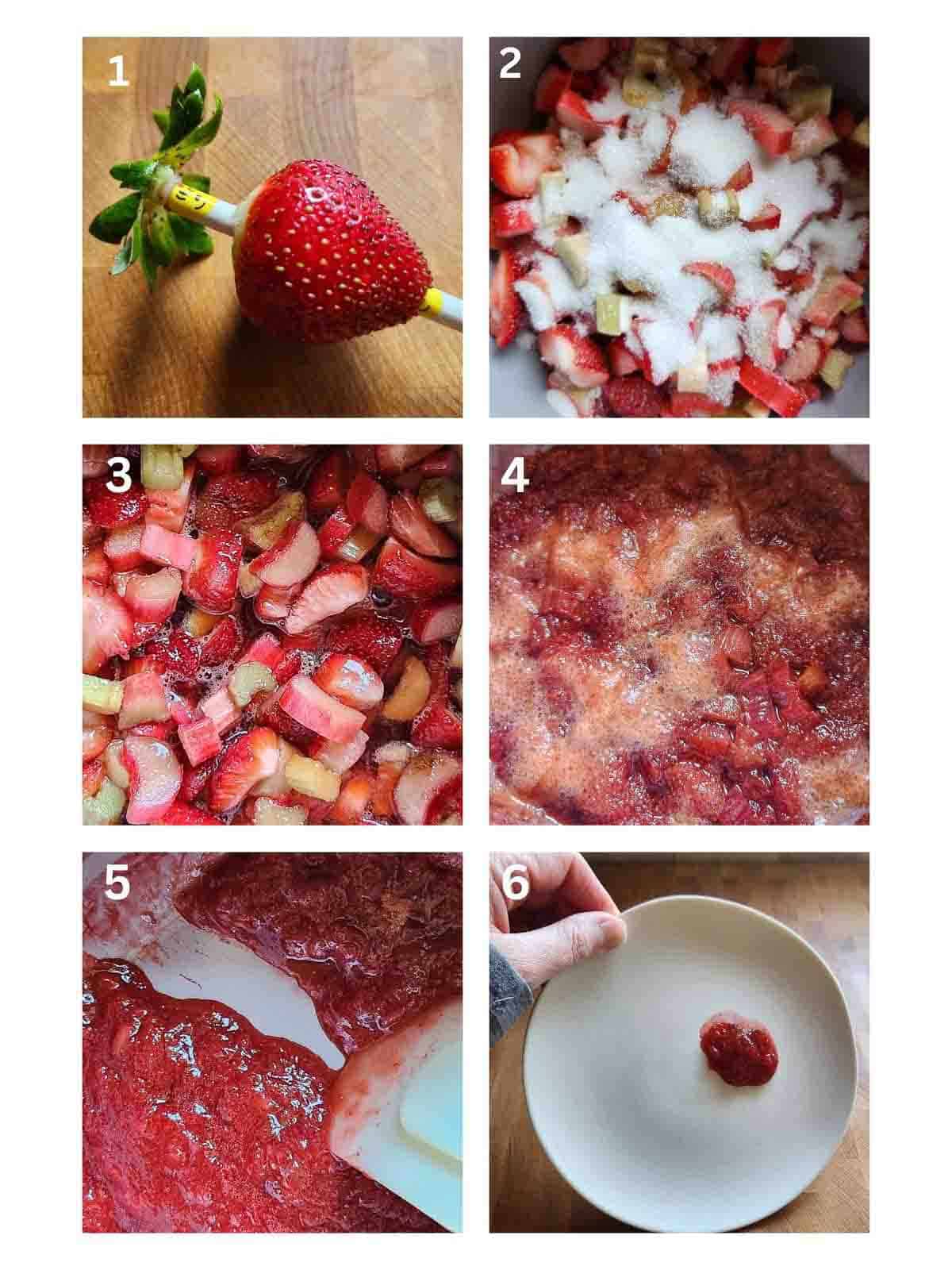
- Prepare the Strawberries: Begin by hulling your fresh strawberries. This means removing the green leafy top and the pale, woody core just beneath it. You can do this efficiently with a small knife or even a straw for a fun and easy method (as shown in Step 1 of the collage). Once hulled, slice them into ½-inch pieces.
- Combine Ingredients: In a medium-sized, heavy-bottomed pot, combine your diced rhubarb, sliced strawberries, lemon juice, sugar (start with the lower amount and adjust later), vanilla, and cinnamon. Give everything a good stir to ensure the fruit is evenly coated.
- Initial Cook with Lid: Place the pot over medium heat. Cover it with a lid and let it cook for approximately 5 minutes. This initial covered cooking period allows the fruit to release its juices and the sugar to dissolve, creating a beautiful syrupy base.
- Uncovered Simmer: Remove the lid and continue to cook the mixture over medium heat. Stir occasionally to prevent sticking and ensure even cooking. You’ll notice the fruit breaking down and the liquid beginning to reduce. The image in the collage at the 15-minute mark gives you a good visual guide of the consistency you’re aiming for.
- Thickening Stage: Continue cooking for another 10-15 minutes, or until the jam has thickened significantly and is almost set. This usually takes a total of 20-25 minutes from the start of the uncovered simmer. The jam will continue to thicken as it cools, so don’t overcook it. If it starts to bubble too vigorously or seems to stick to the bottom, simply reduce the heat to medium-low.
- Test for Readiness: To confirm your jam is perfectly set, perform either the spatula test (see Step 5 in the collage) or the plate test (Step 6). These simple methods will tell you if your jam has reached the ideal consistency.
Detailed instructions, along with specific measurements, are provided in the recipe card below.
Mastering the Jam Set: How to Know When Your Jam is Ready
Knowing exactly when your homemade jam has reached its perfect set point can be a bit tricky for beginners, as it continues to thicken off the heat. Fortunately, there are a couple of reliable methods to ensure your small-batch strawberry rhubarb jam is just right: not too runny, and not overly stiff.
The most common method is the Spatula Test (as seen in Step 5 of the instructions):
Around the 18-20 minute mark of simmering, lift your spatula or a wooden spoon from the jam and let the jam drip off. Then, create a “parting” line down the center of the jam in the pot using your spatula. If the jam falls back into itself slowly, rather than immediately rushing back together, it’s a good indication that it’s nearly ready. The slower it comes back together, the thicker your final jam will be.
Another highly effective technique is the Plate Test (illustrated in Step 6 of the instructions):
Before you even start cooking, place 2-3 small ceramic plates in your freezer to chill thoroughly. When you suspect your jam is close to being set, take one chilled plate from the freezer. Drop a small spoonful (about a tablespoon) of hot jam onto the cold plate. Let it sit for about 30-60 seconds to cool. Then, using your finger, gently push the jam. If it wrinkles and holds its shape, or if you can tilt the plate and the jam runs very slowly or not at all, it’s perfectly set! If it’s still too liquid, continue cooking for a few more minutes and repeat the test with another chilled plate.
Remember, your jam will firm up considerably as it cools, so it’s always better to slightly undercook than overcook at this stage.
Get Creative: Jam Variations and Flavor Boosters
While the classic strawberry-rhubarb combination is undeniably delicious, this small-batch jam recipe offers a fantastic canvas for culinary creativity. Feel free to make a few adjustments to suit your personal taste or to simply experiment with new flavors:
- Fruit Swaps:
- Raspberry Rhubarb Jam: For a slightly different berry note, try swapping some or all of the strawberries for fresh raspberries. Raspberries offer a more intense, sometimes tarter, berry flavor that pairs beautifully with rhubarb.
- Berry Medley: Combine strawberries and rhubarb with other berries like blueberries or blackberries for a complex mixed-berry jam.
- Rhubarb Only: If you’re a true rhubarb aficionado, you can certainly leave out the strawberries altogether for a pure rhubarb jam. You might need to adjust the sugar content upwards slightly, as rhubarb is quite tart on its own.
- Spice It Up:
- Cardamom Infusion: Add a pinch of ground cardamom for an exotic, fragrant twist. Its warm, citrusy notes complement both strawberries and rhubarb wonderfully.
- Ginger Kick: A small amount of freshly grated ginger can add a lovely warmth and a subtle spicy kick.
- Star Anise: For a sophisticated flavor, add one or two whole star anise pods during cooking, removing them before jarring.
- Aromatic Additions:
- Rose Water: For a unique, floral spin, a hint of rose water (just a few drops at the end of cooking) can transform your jam into something truly special.
- Orange Zest: Replace or complement the lemon juice with some finely grated orange zest for a brighter, more citrusy aroma.
- Fresh Herbs: A sprig of fresh mint or basil added during the last few minutes of cooking can infuse the jam with a surprising herbaceous freshness. Remove the sprig before jarring.
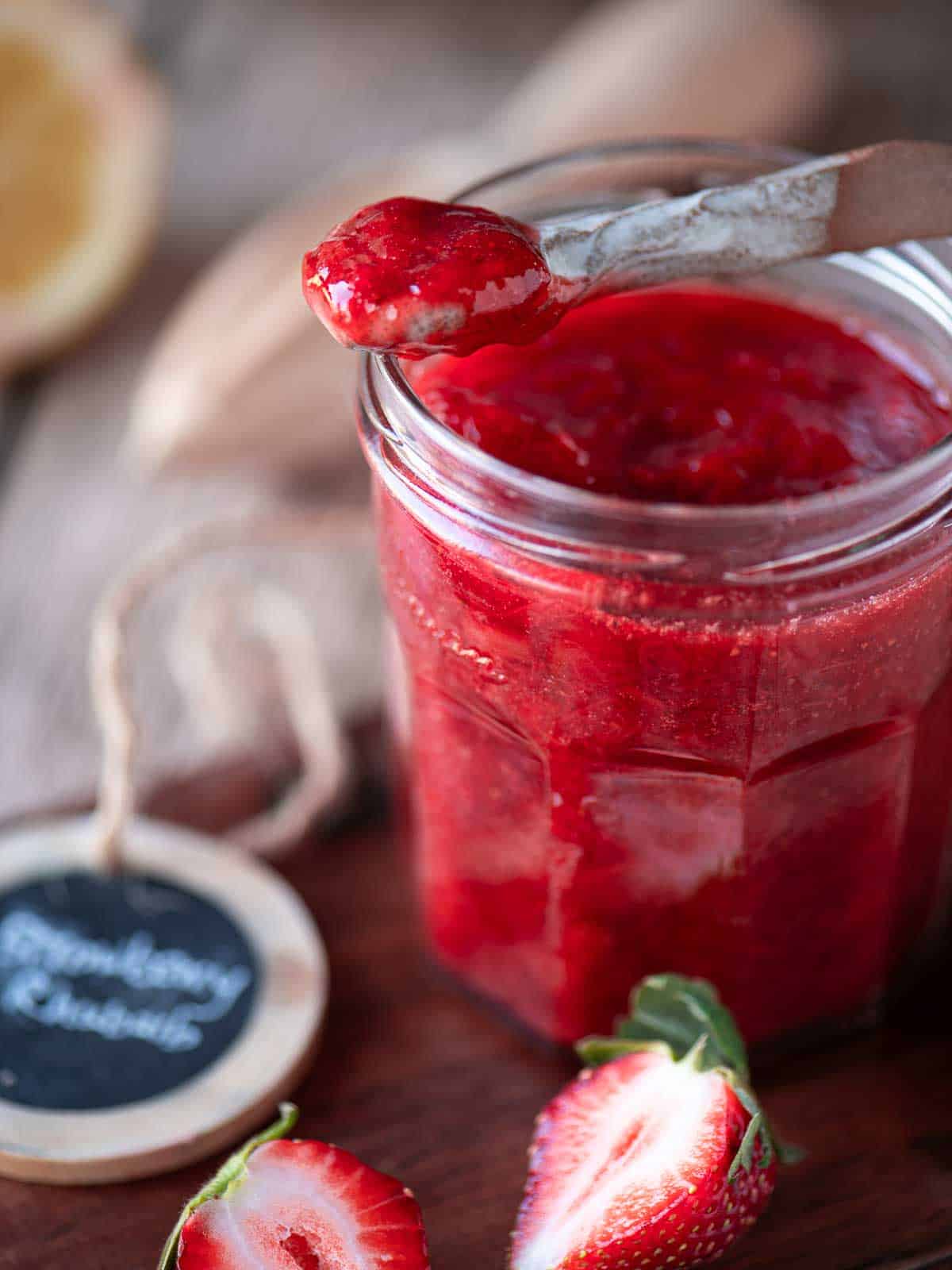
Endless Ways to Enjoy Your Jam
Gone are the days when jam was solely destined for toast. This luscious small-batch strawberry rhubarb jam is incredibly versatile and can elevate a multitude of dishes. Get ready to “spread the love” with these creative serving suggestions:
- Classic Breakfast Delights: Indulge in warm, buttery biscuits or light, fluffy sweet scones generously slathered with your homemade jam. It’s also exquisite drizzled over stacks of golden pancakes or crispy waffles, especially when paired with a dollop of whipped cream or a dusting of powdered sugar.
- Yogurt and Oatmeal Booster: Stir a spoonful or two into your morning Greek yogurt or creamy oatmeal for a burst of natural sweetness and fruit flavor. For a more elegant treat, layer it up in a fruit parfait with granola and creamy components.
- Gourmet Cheese Pairing: Transform your charcuterie board by serving this jam alongside artisanal cheeses. It pairs exceptionally well with creamy brie, tangy goat cheese, or sharp cheddar, offering a delightful sweet and savory contrast.
- Dessert Enhancer: Spoon it generously over scoops of vanilla (or even pistachio!) ice cream for an instant upgrade, or blend it into homemade milkshakes for a fruity twist. It also makes a fantastic filling for thumbprint cookies or a glaze for cakes.
- Savory Sandwiches with a Twist: Move beyond the traditional PB&J! Try pairing this jam with strong cheeses in a grilled cheese sandwich for a surprisingly delicious sweet and savory experience.
- Baking Applications: Use it as a vibrant filling for buttery thumbprint cookies, tartlets, or as a topping for cheesecakes. It can also be spread on top of warm breakfast breads or a simple fruit cake for added moisture and flavor. Feeling ambitious? Use it as the star filling for these adorable homemade mini pies!
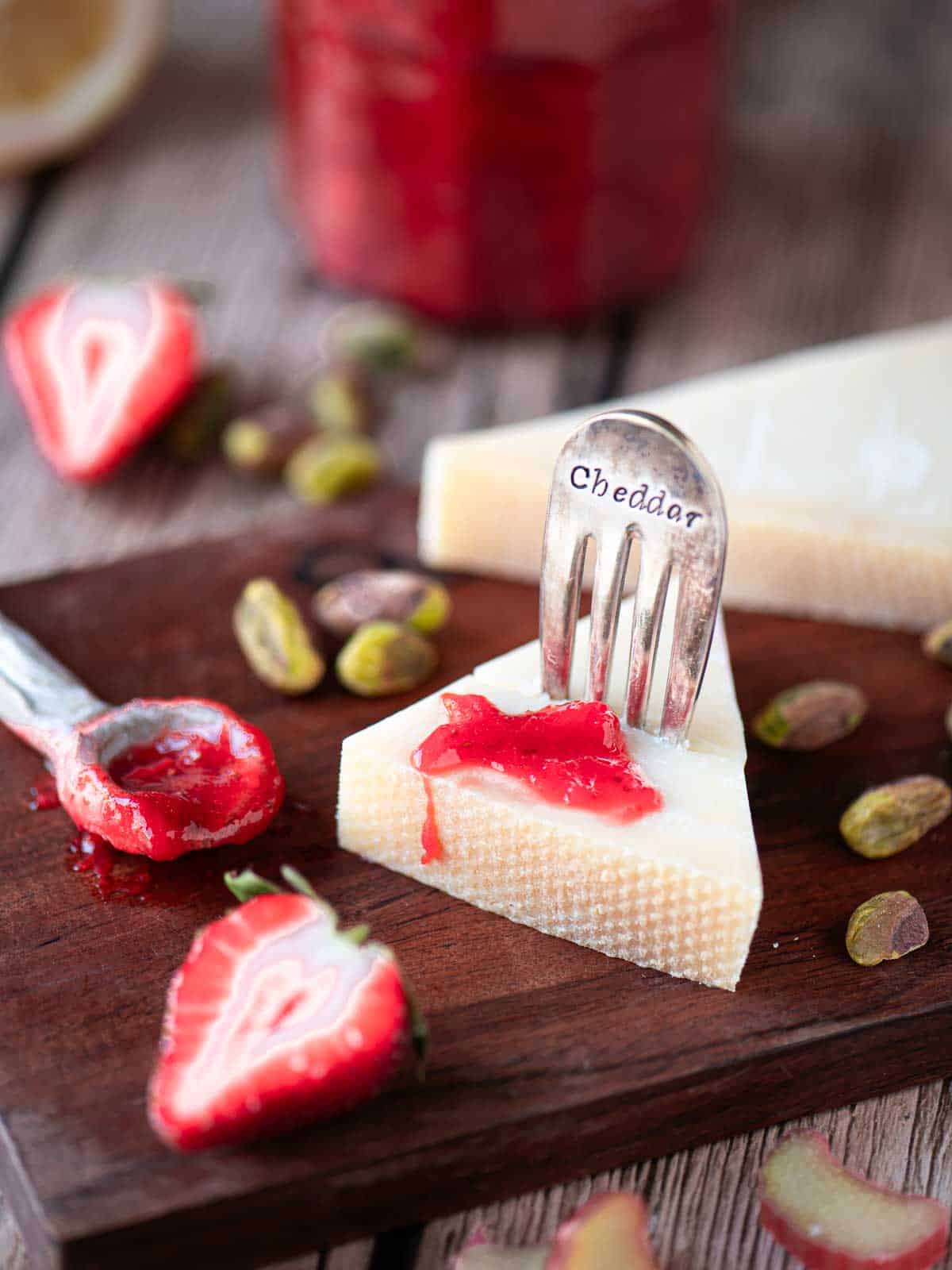
Storing Your Delicious Jam
Because this is a small-batch, no-canning recipe, proper storage is key to enjoying your homemade strawberry rhubarb jam safely and for as long as possible. The good news is, it’s incredibly simple!
- Refrigeration: Once cooled completely, transfer your jam to clean, airtight glass jars. Stored in the refrigerator, this jam will maintain its fresh flavor and quality for about 3-4 weeks. While it might last longer, it’s best enjoyed within this timeframe for optimal taste and texture. Glass jars are preferred over plastic, as they don’t absorb odors and keep the jam tasting purer.
- Freezing: For longer-term storage, freezing is an excellent option. Again, use clean, airtight containers, preferably glass jars with ample headspace (leave at least ½ inch from the top to allow for expansion during freezing). Your homemade strawberry rhubarb jam can be frozen for up to 6 months. When you’re ready to enjoy it, simply thaw it in the refrigerator overnight.
Remember to always use clean utensils when serving to prevent contamination and extend the jam’s shelf life.
Frequently Asked Questions
Rhubarb has a distinctly tart, tangy, and slightly sour taste, often compared to a mix of green apples and lemons. Because of its pronounced acidity, it is almost always cooked with sugar or honey to balance its flavors. When eaten raw, it’s quite crunchy and very sour, but cooking softens its texture and develops a more mellow, fruity flavor that harmonizes beautifully with both sweet and savory ingredients.
When selecting rhubarb, look for firm, crisp stalks that are vibrant red to pink. While some varieties can be greener, the redder stalks typically offer more visual appeal in your finished dish. Avoid any stalks that appear limp, bruised, or have soft spots, as these are signs of older or damaged rhubarb. Rhubarb leaves are toxic, so they are usually removed before the stalks are sold. You can typically find fresh rhubarb in grocery stores, farmers’ markets, or specialty produce shops during its peak season in spring and early summer.
Generally, no, you do not need to peel rhubarb for baking or making jam. The skin is quite thin and softens beautifully when cooked, contributing both color and flavor to your dish. However, there are exceptions: if you encounter rhubarb stalks that are exceptionally thick, noticeably fibrous, or particularly tough, you might consider peeling the outer layer. This can be done by gently pulling off the strings with a small knife or a vegetable peeler, similar to how you’d string celery. This step is usually only necessary for older, tougher stalks to ensure a smoother texture in your final product.
Yes, you absolutely can! If fresh strawberries and rhubarb are out of season, or if you simply have frozen fruit on hand, they work wonderfully in this recipe. There’s no need to thaw the fruit beforehand; just add the frozen strawberries and rhubarb directly to the pot with the other ingredients. The cooking time might be slightly longer to account for the extra moisture released by the frozen fruit, but the end result will be just as delicious.
Lemon juice plays several vital roles in jam making, even in small-batch recipes without added pectin. First, it contributes acidity, which helps to brighten the fruit flavors and balance the sweetness of the sugar. More importantly, the acid in lemon juice helps to activate the natural pectin present in fruits like strawberries and rhubarb, encouraging the jam to set properly. Without sufficient acidity, your jam might remain too runny. It also acts as a natural preservative, inhibiting bacterial growth and enhancing the shelf life of your jam.
Related recipes
Love fruit? So do we! Explore these other delightful fruity recipes that capture the essence of fresh produce in creative ways.
- Fresh Watermelon Water
- Roasted Balsamic Fig Toast
- Labneh Toast with Roasted Strawberries
- Blackberry Boursin Grilled Cheese
Did you make this delightful jam recipe? I would absolutely love to hear about your experience! Please leave a ⭐⭐⭐⭐⭐ rating with a comment right below the recipe card to share your thoughts. And if you snap a photo of your beautiful creation, don’t forget to tag me on Instagram @brunchandbatter. Your culinary adventures inspire me!
📖Recipe
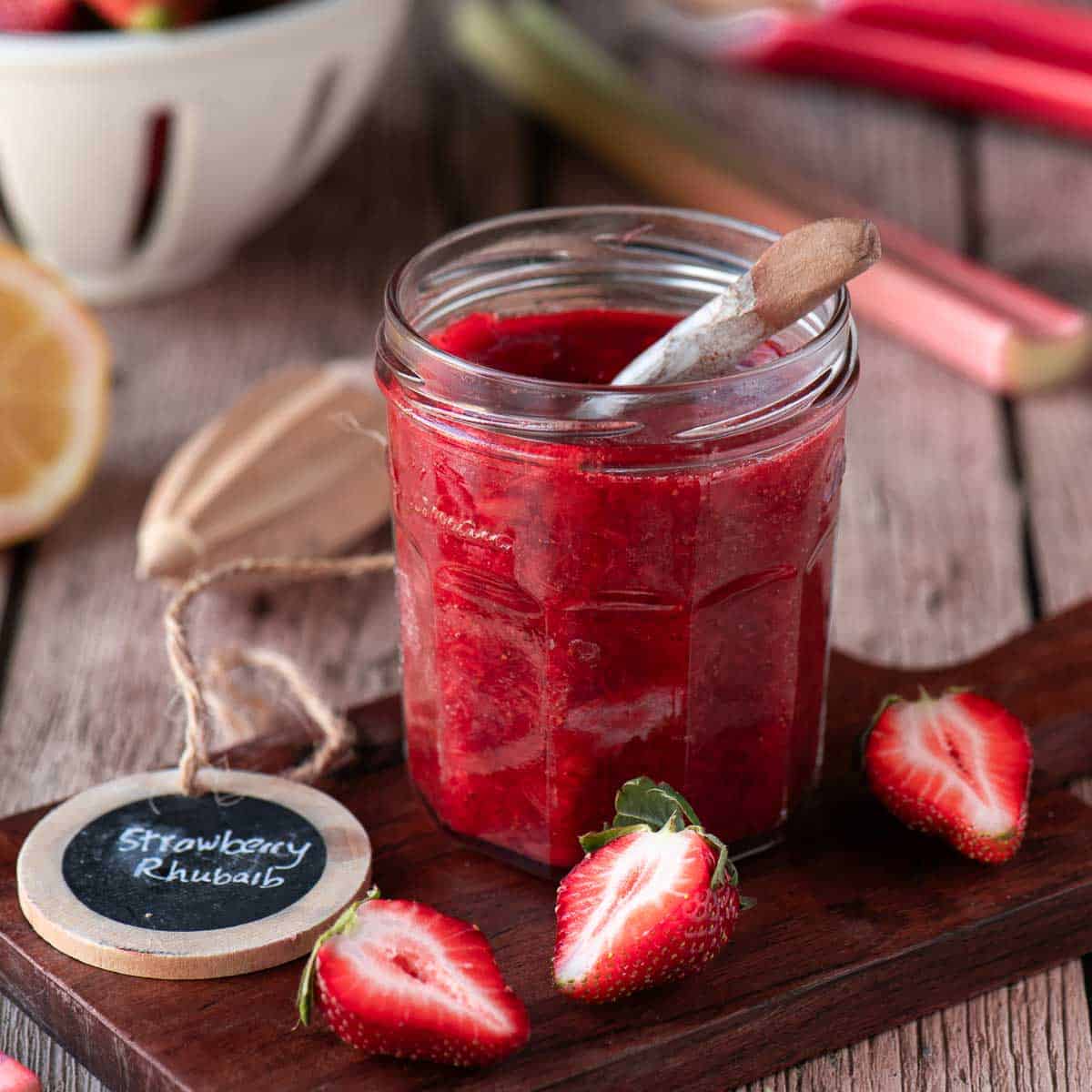
Small Batch Strawberry Rhubarb Jam
Prevent your screen from going dark
Pin Recipe
10 minutes
25 minutes
35 minutes
Breakfast
American
1 cup
42 kcal
Equipment
-
1 medium saucepan
Ingredients
- 1½ cups rhubarb, diced into ½ inch pieces
- 2 cups strawberries, stemmed and sliced into ½ inch pieces measure after you dice
- 1 teaspoon fresh lemon juice
- ¼-½ cup granulated sugar
- ¼ teaspoon cinnamon
- ¼ teaspoon vanilla bean paste or vanilla extract
Instructions
-
Place the rhubarb, strawberries, ¼ cup sugar (or more if your strawberries aren’t sweet), lemon juice, cinnamon, and vanilla in a medium-sized saucepan set over medium heat. Cover with a lid and cook for about 5 minutes, stirring once or twice to combine.1½ cups rhubarb, diced into ½ inch pieces,
2 cups strawberries, stemmed and sliced into ½ inch pieces,
1 teaspoon fresh lemon juice,
¼-½ cup granulated sugar,
¼ teaspoon cinnamon,
¼ teaspoon vanilla bean paste or vanilla extract -
After 5 minutes, remove the lid and continue cooking over medium heat, stirring occasionally until most of the liquid is gone and the jam becomes thick, about 25 minutes (the jam will continue to thicken as it cools). If the jam is bubbling too quickly or starts to stick, lower the heat to a medium-low.
-
Cool the jam completely before refrigerating.
Notes
- See the recipe post for pictures showing how to check if your jam is ready. You’ll know it’s almost set when you can run a spatula down the center of the jam in the pot, and it falls back slowly onto itself. Note: The jam will continue to thicken once taken off the heat.
- This jam will keep in the refrigerator for 3-4 weeks. Alternatively, you can freeze the jam for up to 6 months. Yields approximately 1 cup of jam. Store in glass jars.
Nutrition*
Serving:
2
tablespoon
Calories:
42
kcal
Carbohydrates:
10.7
g
Protein:
0.5
g
Fat:
0.2
g
Sodium:
1
mg
Potassium:
129
mg
Fiber:
1.2
g
Sugar:
9
g
Calcium:
27
mg
*Nutrition information is provided as a courtesy and is an estimate only. Nutrition information can vary depending on many factors, such as products used, measurements and substitutions, therefore it is recommended that you obtain nutritional calculations based on your own finished recipe.
Have you tried this recipe?
Leave a comment below and share a photo on Instagram. Tag @brunchandbatter or hashtag it with #brunchandbatter
